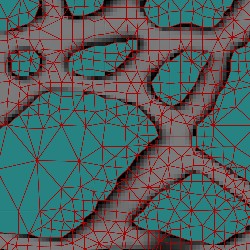
OOF helps researchers identify the different substances -- blue and gray areas -- that make up the material and compute their response to stress or other effects. (S. Langer, NIST)
Computer scientists at the National Institute of Standards and Technology (NIST) in Gaithersburg, Maryland have improved its software for materials engineers to calculate the impact of stress on the internal structure of materials. The Object-Oriented Finite (OOF) element analysis software is available as a free download that runs on Unix systems or derivatives, such as Linux.
The OOF software helps materials designers understand how stress and other factors act on a material with a complex internal structure, such as many alloys and ceramics. OOF works from micrographs, images of a material taken by a microscope, and forecasts the behavior of the material under specified stresses, such as physical force or temperature changes (example at right).
According to NIST, the new version 2.1 of the software is its first major upgrade since the agency — part of the U.S. Department of Commerce — first released it in 1998. Team member Stephen Langer says, the new version of the software improves the “ability to envision non-linear behavior, such as large-scale deformation, which plays a significant role in many types of stress response.” Langer adds that “It also allows users to analyze a material’s performance over time, not just under static conditions” as before.
The new version of the software also offers templates to make it easier for users to add their own details and conditions. Later this year, the team expects to enable users to analyze three-dimensional micrographs of a material, rather than the 2-D images now processed by the software.
* * *

 RSS - Posts
RSS - Posts
You must be logged in to post a comment.